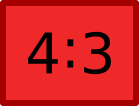 Aspect ratio is the different screen sizes, videos are shot in. The common sizes are 4:3 and 16:9. For the last 50 years films have been shot in 16:9 wide-screen, but viewers had only been able to watch it in slandered 4:3 screen, but in the last decade or so wide-screen screen TV has become available, Improving Peoples television viewing.
Aspect ratio is the different screen sizes, videos are shot in. The common sizes are 4:3 and 16:9. For the last 50 years films have been shot in 16:9 wide-screen, but viewers had only been able to watch it in slandered 4:3 screen, but in the last decade or so wide-screen screen TV has become available, Improving Peoples television viewing. 
Pan and Scan
Pan and scan is the method adjusting a wide-screen shot to a standard 4:3 shot used for stranded televisions. The method involves cropping the film in a way that the important aspects from the scenes in the shot are not affected. Normally the insignificant parts in a shot are cropped out. The picture to the right is a good example or pan and scan. (Picture from

Pillar-box
Pillar boxing is the opposite method of pan and scan. It’s a screen shot that wasn’t shot in wide-screen but is then formatted to play in wide-screen.

TV motion and Pixels
Pixels – pixels are tiny colourful squares that form together to form a still picture. When a still image is divided into a collection of little dots, our brains take in the arrangement of the dots to form a still image. The more pixels in a picture the better quality the turn out of the picture is. There are 25 frames per a second in films in the UK.
The TV screen
A video camera divides up an image into horizontal scan line, which makes up every single frame; this is then transmitted to our televisions. Different countries have different standards or systems of lines per a second and different numbers of frames per second.
No comments:
Post a Comment